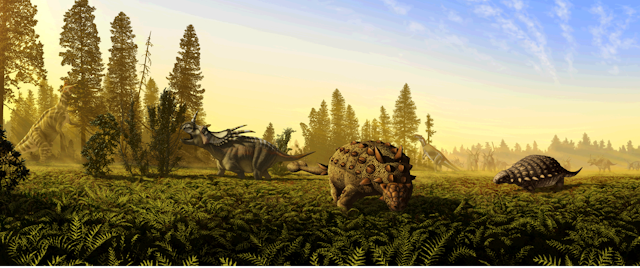Life on Earth is most diverse at the equator. This pattern, where species biodiversity increases as we move through the tropics towards the equator, is seen on land and in the oceans, and has been documented across a broad range of animal and plant groups, from mammals and birds, to ants and even trees.
Despite this pattern being so striking today, the distribution of biodiversity across latitudes – called the latitudinal biodiversity gradient – hasn’t always been like this. Studies looking at the evolution of biodiversity by latitude have shown that during some intervals in Earth’s history, species biodiversity was actually highest at latitudes far from the equator.
Understanding why latitudinal biodiversity has shifted over hundreds of millions of years, often linked to mass extinction events, is critical in today’s world, where we’re facing climate change, habitat loss and decreasing biodiversity worldwide. Looking back in geological time reveals an alarming picture of what we’re set to lose if we fail to address increasing global temperatures.
Read more: What is a 'mass extinction' and are we in one now?
Several different hypotheses have been proposed to explain why high biodiversity clusters around certain latitudes, but climate is often regarded as a key driver, both in the present day and through history as shown by the geological record. Climate affects organisms in many ways, including where they can live, when they reproduce, and even how they control their internal processes such as temperature regulation.
Modern biodiversity peaks in low-latitude equatorial regions, such as in the tropical rainforests of the Amazon and central Africa. This pattern is more likely to be recorded during “icehouse” times, when ice sheets are present in both poles simultaneously – like today.
During warmer intervals, called “hothouse” or “greenhouse” Earth states, bimodal peaks have been recorded. This means there were two bands where biodiversity was highest, and these wrapped around the Earth at mid-latitudes, or regions sitting between 25° and 65° north and south of the equator.

The fossil record provides our best window into Earth’s ancient biodiversity. But estimating patterns of biodiversity from the fossil record has been tricky, because it’s riddled with gaps and biases that limit our understanding.
But in the past two decades, new analytical techniques have allowed palaeontologists to estimate what prehistoric biodiversity patterns might have looked like, even from data that might appear, superficially at least, a little patchy. These techniques have recently revealed what latitudinal diversity looked like over 200 million years ago, in the aftermath of the most devastating mass extinction events ever recorded.
Prehistoric habitats
The end-Permian mass extinction, which took place 251 million years ago, resulted in the extinction of over 80% of species on Earth. The extinction event was caused by an unstable climate after widespread volcanic eruptions. At this time, and for the following 50 million years of the Triassic period, the continents were arranged into a single landmass, known as Pangaea.
The climate of the period was generally hotter and more arid than the present day, and vast deserts surrounded the equator. Instead of ice sheets, polar regions had temperate climates, like those we find at mid-latitudes today. Life in the oceans, meanwhile, was not only subjected to equatorial sea surface temperatures as high as 40°C, but also falling oxygen levels and ocean acidification.
Read more: Global warming’s evil twin: ocean acidification
The period following the end-Permian mass extinction was one of recovery. A recent study found a latitudinal diversity gradient in the oceans similar to today’s was present for much of the Triassic (251–201 million years ago). Immediately following the mass extinction event, however, the researchers found a flat biodiversity gradient. There was no peak in species biodiversity at any latitude, which they attributed to high extinction rates near the equator due to extreme warming and ocean anoxia – when oxygen in ocean water is depleted.
On land, the vertebrates that survived the mass extinction soon developed a bimodal latitudinal biodiversity gradient, with the highest peak occurring in low-latitude regions of the northern hemisphere, but with a second peak in mid-latitude regions of the southern hemisphere. This pattern is likely to have been driven by the extreme climatic conditions on Pangaea, including high temperatures and strongly seasonal rainfall, associated with the formation of a “megamonsoon”.

Later in the Triassic, on the approach to yet another mass extinction event, most land vertebrates, including early mammals and early dinosaurs, exhibited high diversity at mid-latitudes, both north and south of the equator. This pattern is similar to that recorded for land vertebrates during the Permian period, just before the mass extinction.
One exception were the pseudosuchians – the group that consists of crocodilians and their fossil relatives. Interestingly, while the latitudinal biodiversity of other species shifted over the subsequent 200 million years, arriving at the equator in the present day, pseudosuchian biodiversity has remained highest at low latitudes throughout their entire evolutionary history.
This is likely due to their physiology, specifically their tolerance of high temperatures. Reptiles are ectotherms, or “cold-blooded” organisms, that rely on their external environment to regulate their internal body temperature. Today, crocodiles and other reptiles are restricted to areas of the world with warmer, more stable temperatures, and the same would have been true of their fossil relatives.
Prehistory repeats?
These insights into past mass extinction events are critical for understanding how Earth’s current patchwork of biodiverse regions could change. As global temperatures continue to rise, some studies have predicted that species will disperse towards the poles from equatorial regions – but if the pace of change is too rapid, they risk going extinct.
Others suggest that global warming might lead to the climate becoming more similar across different latitudes, potentially producing a peak in biodiversity at mid-latitudes. There’s already evidence that marine latitudinal biodiversity has become increasingly bimodal over the last 50 years.
With a possible “sixth mass extinction” looming, or even already taking hold, a long-term perspective will be critical for understanding how to sustain Earth’s biodiversity into the future.

